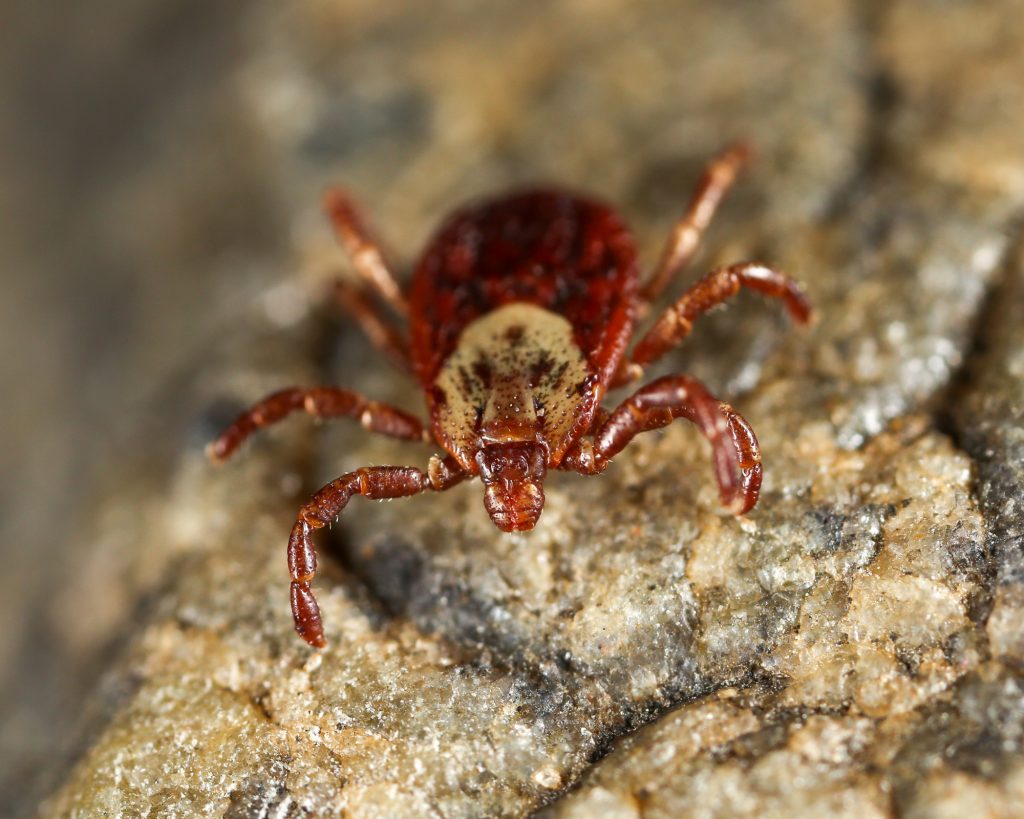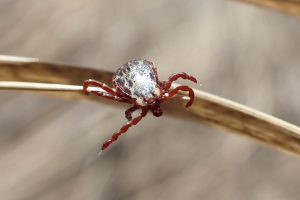Ticked Off

BY SARAH HATT
As you get ready for bed, your mind wanders and you think, "Did I lock the door? Did I turn off the stove? Did I blow out that candle...?" But did you remember to check for unwanted guests that may have hitched a ride home with you on your afternoon hike? It could be that tiny pests are ready to dig in for a feast!
COVID-19 pandemic restrictions have resulted in more people heading outdoors for recreation than ever before and it is important to be mindful of the hazards that can be encountered. Risks come in all shapes and sizes. Big ones like bears, avalanches, and extreme weather conditions are readily apparent, and even smaller-scale risks, like tripping hazards from exposed roots, are fairly obvious and easily avoided. But some of the tiniest hazards, like ticks, can easily go unnoticed.
There are numerous tick species in Alberta, but the three most common are the blacklegged or deer tick (Ixodes scapularis), the brown or American dog tick (Dermacentor variabilis), and the Rocky Mountain wood tick (Dermacentor andersoni). Though often thought of as insects, ticks are arachnids. As such, they have just two body regions and eight legs upon maturity. It may be comforting to know that ticks are flightless and do not jump like fleas. Most tick species do not have eyes and rely on senses that can detect body heat and carbon dioxide to find hosts. Circumstances that lead to direct contact and tick transfers include walking through grasses and shrubs and contact with livestock or animals.
Most ticks do not carry diseases, and most tick bites do not cause serious health problems. But it is good to understand the risks. The most serious tick-borne illness is Lyme disease, which can cause long-term disability if left untreated. So far, Lyme disease has not been reported within Alberta; however, 132 Albertans have acquired Lyme disease over the past 30 years while travelling elsewhere.1 Within Alberta, the main tick-borne diseases are Rocky Mountain spotted fever, Powassan virus, and tularemia. The number of cases of these diseases reported to Alberta Health is very low, ranging from 0 to 3 per year.1
Though the risk of serious disease is low, knowing prevention and removal methods can help ensure that you do not become ill. Tick prevention methods include:
- Avoid heavily wooded or thick grass areas if possible.
- Stick to the centre of trails to avoid rubbing against vegetation.
- Cover exposed skin with long pants, sleeves, and shoes. Tuck pants into socks to prevent ticks from crawling inside.
- Use approved DEET repellent.
- Perform tick checks on pets, children, and yourself.
After being outdoors it’s a good policy to check for ticks. For children and self-checks, remember to check in and around the hairline and scalp, ears, underarms, waist, belly button, between legs, and behind the knees. When performing checks on pets, make sure to check in and around their ears, around their eyelids, between their toes, around their tails, between and under legs, and around their collars.
A few other tips and tricks to avoid bringing ticks home with you:
- Pay extra attention to shoelaces and zippers during checks.
- Keep a lint roller in your vehicle to roll over clothing and pick up ticks you may have missed.
- Rolled-up sleeves or creases in clothing make perfect hiding spots, so make sure to wash clothing in hot water as soon as you can.
- A shower is not only a great way to soothe muscles and relax after an outing, it can also help wash away any ticks you may have missed during your checks.

Rocky Mountain Wood Ticks (Dermacentor andersoni) by Charlie Myles
What if you missed one and have been bitten? Stay calm, and remove the tick as soon as possible. The faster a tick is removed, the lower the risk of contracting an illness.
To properly remove a tick, use tweezers to grasp the tick by its head, as close to the skin as possible, and pull straight out. Do not twist, because the head and mouthparts could break off within the skin, and do not squeeze the tick body. Once removed, wash the bite area with soap and water or an alcohol-based sanitizer. If you are not comfortable removing the tick, see a health care professional.
It is best not to use smothering agents (Vaseline, liquid soap, etc.), heat, or other tricks to encourage ticks to detach from a host as this may cause the tick to expel its stomach contents into the host as it makes an emergency exit. This increases the risk of contracting an infection if the tick is a carrier for diseases.
For further information about ticks in Alberta, tick surveillance, and the Submit-a-Tick program, please visit alberta.ca/lyme-disease-tick-surveillance.aspx
References
- Government of Alberta, Lyme disease and tick surveillance website: alberta.ca/lyme-disease-tick-surveillance.aspx
This article originally ran in Nature Alberta Magazine - Summer 2021
